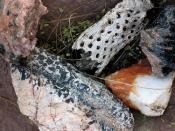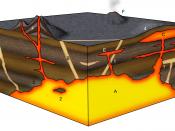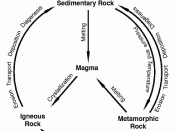In my opinion yes ultimately all rocks are derived from igneous rocks, but we have to keep in mind that rocks are always in movement. With reference to the rock cycle this could be explained better. The Rock Cycle was probably the first of Earth's cycles or systems to be recognized and studied, at least in a qualitative sense and it is made up of three rocks, igneous, sedimentary and metaphoric.
Igneous rock can change into sedimentary rock or into metamorphic rock. Sedimentary rock can change into metamorphic rock or into igneous rock. Metamorphic rock can change into igneous or sedimentary rock.
Igneous rocks are called fire rocks and are formed either underground (intrusive) or above ground (extrusive). Underground, they are formed when the melted rock, called magma, deep within the earth becomes trapped in small pockets. As these pockets of magma cool slowly underground, the magma becomes igneous rocks. Igneous rocks are also formed when volcanoes erupt, causing the magma to rise above the earth's surface. When magma appears above the earth, it is called lava. Igneous rocks are formed as the lava cools above ground. On Earth's surface, wind and water can break rock into pieces. They can also carry rock pieces to another place. Usually, the rock pieces, called sediments, drop from the wind or water to make a layer. The layer can be buried under other layers of sediments. After a long time the sediments can be cemented together to make sedimentary rock. In this way, igneous rock can become sedimentary rock.
All rock can be heated. Inside Earth there is heat from pressure, friction and from radioactive decay. By this way rocks are like being baked, they do not melt but they change. It forms crystals and if it has crystals already,


